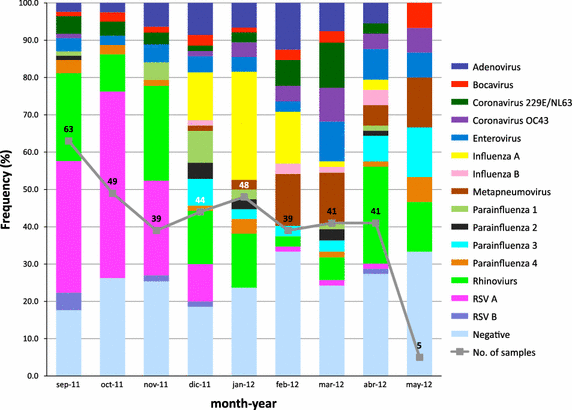Prevalence of respiratory virus in symptomatic children in private physician office settings in five communities of the state of Veracruz, Mexico
- PMID: 26108920
- PMCID: PMC4479372
- DOI: 10.1186/s13104-015-1239-0
Prevalence of respiratory virus in symptomatic children in private physician office settings in five communities of the state of Veracruz, Mexico
Abstract
Background: Acute respiratory tract infections are the leading cause of morbidity and mortality in children worldwide. Many studies have described the frequency of viruses in hospitalized patients, but studies describing the prevalence of viruses in the community setting are limited, particularly in developing countries, where most of the deaths from serious respiratory diseases occur. The aim of this study was to evaluate the diversity of respiratory viruses in the community setting using molecular diagnostic tools, as well as the clinical characteristics of respiratory viral infections in the general pediatric practice in Mexico.
Methods: Children with respiratory tract infections attending private pediatric practices during a 10-month period in five cities of the state of Veracruz were included. Nasal swabs were taken and processed by a multiplex detection kit for 15 respiratory viruses.
Results: 525 children were included from July 2011 to May 2012; 44% were female, mean age was 45 months. The 3 most frequent clinical diagnosis were: rhinopharyngitis 68%, pharyngitis 18%, and 3.3% influenza-like illness. 71.5% of the samples were positive for virus. The five most frequent pathogens were respiratory syncycitial virus in 18.3% of the children, rhinovirus in 17.5%, influenza A 9.1%, adenovirus 7.2%, and enterovirus 3.4%, although all 15 viruses were detected; there were viral coinfections in 14.1%, and 28.5% of the samples were negative.
Conclusions: A large proportion of respiratory infections in the community setting in Mexico was associated to viruses. Although testing for common respiratory pathogens in children with acute respiratory tract infections may lead to a better understanding of the role of viral pathogens in, and eventually to improvement in the management of, individual patients, additional prospective studies are required to study the need of routinely using such tests in general pediatric practices in resource-limited countries.
Figures


References
-
- WHO (2014) World health statistics. In: WLCiP D (ed) Global health indicators. http://apps.who.int/iris/bitstream/10665/112738/1/9789240692671_eng.pdf?...
-
- Anuarios de morbilidad. Dirección general de Epidemiología. Secretaría de Salud. http://www.epidemiologia.salud.gob.mx/anuario/html/anuarios.html. Accesed 16 April 2015
-
- Global initiative for asthma. http://www.ginasthma.org/documents/4
Publication types
MeSH terms
LinkOut - more resources
Full Text Sources
Other Literature Sources

